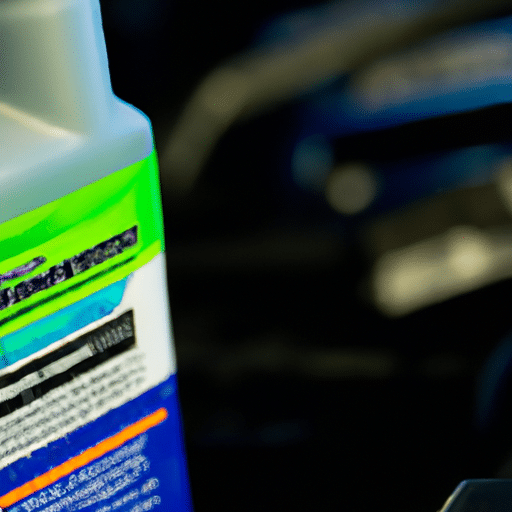Let’s talk about fuel injector cleaner and how to use it effectively. When it comes to maintaining our vehicles, it’s important to understand the proper techniques to keep our engines running smoothly. Fuel injector cleaner can help eliminate clogs, improve performance, and increase fuel efficiency. In this article, we’ll explore the step-by-step process of using fuel injector cleaner, so you can ensure your car continues to run efficiently and effortlessly.
Preparation
Gather the necessary materials
Before starting the process of cleaning your fuel injectors, it’s important to gather all the necessary materials. These will include a fuel injector cleaner, which can be purchased from an auto parts store or online, as well as any tools that may be required to access the fuel injector. Check your vehicle’s manual or consult with a professional to determine the specific tools needed for your particular vehicle.
Read the instructions
Once you have all the materials ready, take some time to thoroughly read the instructions provided with the fuel injector cleaner. The instructions will provide important information on how to use the cleaner properly and safely. Make sure you understand each step before proceeding to avoid any potential issues or damage to your vehicle.
Identify the Problem
Recognize symptoms of clogged fuel injectors
Clogged fuel injectors can lead to a variety of issues in your vehicle. Some common symptoms include rough idling, decreased fuel efficiency, engine misfires, and a noticeable decrease in performance. If you experience any of these symptoms, there is a possibility that your fuel injectors may be clogged and in need of cleaning.
Diagnose the issue
To confirm whether your fuel injectors are indeed clogged, it is important to perform a proper diagnosis. This can be done using a diagnostic tool that can read your vehicle’s on-board computer. Alternatively, you can visit a mechanic or automotive professional who can perform the diagnosis for you. Once the issue has been determined, you can proceed with the cleaning process.
Choosing the Right Cleaner
Consider the type of fuel injector cleaner
There are different types of fuel injector cleaners available in the market, each designed for specific applications. Some cleaners are designed for gasoline engines, while others are formulated for diesel engines. It is crucial to choose the cleaner that is appropriate for your vehicle’s engine type. Refer to your vehicle’s manual or consult with a professional to ensure you select the correct cleaner.
Research and read reviews
Before purchasing a fuel injector cleaner, take the time to research and read reviews from other customers. This can provide valuable insights into the effectiveness and reliability of different products. Look for cleaners that have positive reviews and are recommended by professionals or experienced car owners.
Consult with a professional if unsure
If you are unsure about which fuel injector cleaner to use or have any doubts about the cleaning process, it is always best to consult with a professional. They can provide expert advice and guidance specific to your vehicle’s needs. Don’t hesitate to reach out to a trusted mechanic or automotive specialist who can help you make the right decision.
Preparing for the Cleaning Process
Park your vehicle in a well-ventilated area
Before starting the cleaning process, it is important to park your vehicle in a well-ventilated area. This will ensure that any fumes or exhaust gases are safely dispersed and prevent the buildup of potentially harmful gases in an enclosed space. Outdoor areas or well-ventilated garages are ideal locations to carry out this process.
Ensure the engine is cool
To avoid any accidental burns or injuries, make sure that the engine is cool before attempting to clean the fuel injectors. It is recommended to wait at least an hour after turning off the engine to allow it to cool down completely. Touch the engine gently to ensure it is safe to proceed with the cleaning process.
Relieve fuel system pressure
Before disconnecting any components of the fuel injector system, it is essential to relieve the fuel system pressure. This can be done by locating the fuel pump relay or fuse and removing it to prevent the flow of fuel. This step is crucial to ensure your safety and prevent any fuel spray or leaks during the cleaning process.
Locating the Fuel Injector
Determine the fuel injector’s location
The location of the fuel injector can vary depending on the make and model of your vehicle. To locate the fuel injector, refer to your vehicle’s manual or consult online resources specific to your vehicle’s make and model. The fuel injector is typically found in the intake manifold or along the fuel rail.
Refer to your vehicle’s manual or online resources
If you are unsure about the exact location of the fuel injector, referring to your vehicle’s manual is the best place to start. The manual will provide detailed information and diagrams to help you locate and identify the fuel injector. If you don’t have access to the manual, you can also search online resources specific to your vehicle’s make and model for guidance.
Disconnecting the Fuel Injector
Turn off the engine
Before disconnecting the fuel injector, ensure that the engine is turned off completely. This will prevent any accidental starts or potential hazards during the disconnection process. Safety should always be a top priority when working on your vehicle.
Detach the fuel pump relay or fuse
To safely disconnect the fuel injector, it is necessary to first detach the fuel pump relay or fuse. This step is crucial to cut off the fuel supply and prevent any fuel leakage or spilling during the process. Locate the fuel pump relay or fuse, which is usually located in the engine’s fuse box, and carefully remove it as per the instructions provided in your vehicle’s manual.
Detach the fuel injector
Once the fuel pump relay or fuse is removed, you can proceed to detach the fuel injector. This can typically be done by carefully unplugging the electrical connector that attaches the fuel injector to the wiring harness. Gently remove any clips or brackets holding the fuel injector in place, and finally, disconnect the fuel supply line from the fuel injector.
Cleaning the Fuel Injector
Attach the fuel injector cleaner canister
With the fuel injector detached, it’s time to attach the fuel injector cleaner canister. Follow the instructions provided with the cleaner to properly attach it to the fuel injector. Ensure a secure connection is made to avoid any leaks or spills during the cleaning process.
Start the engine
Once the cleaner canister is properly attached, start the engine as directed by the fuel injector cleaner’s instructions. This will allow the cleaner to flow through the fuel system and into the injectors, effectively cleaning any deposits or buildup that may be present.
Run the engine at a specified RPM
To ensure proper cleaning, it is often recommended to run the engine at a specified RPM for a set duration. Refer to the fuel injector cleaner’s instructions for the specific recommended RPM and duration. Running the engine at this specified RPM will optimize the cleaning process and help remove any stubborn deposits within the fuel injectors.
Monitor the exhaust for smoke or fumes
While the engine is running and the cleaning process is ongoing, it is important to keep an eye on the exhaust. Some fuel injector cleaners may produce smoke or fumes as they break down and remove deposits from the injectors. This is normal and indicates that the cleaner is working effectively. However, if you notice excessive smoke or any unusual odors, it is advisable to abort the cleaning process and consult with a professional.
Reassembling the Fuel Injector
Remove the fuel injector cleaner canister
Once the cleaning process is complete, it’s time to remove the fuel injector cleaner canister. Carefully detach the canister from the fuel injector, ensuring that no residual cleaner spills or leaks during the removal. Dispose of the canister as per the manufacturer’s instructions.
Reattach the fuel injector
With the cleaner canister removed, it’s time to reattach the fuel injector. Gently connect the fuel supply line and secure it in place using any clips or brackets that were detached earlier. Ensure a proper and secure connection is made to prevent any fuel leaks or issues during engine operation.
Reconnect the fuel pump relay or fuse
To restore the fuel supply to the system, it is necessary to reconnect the fuel pump relay or fuse. Carefully place the relay or fuse back into its original position in the engine’s fuse box according to the instructions provided in your vehicle’s manual. This will allow fuel to flow through the system and prepare the vehicle for testing.
Testing the Vehicle
Start the engine
With the fuel injector reassembled and the fuel system reconnected, start the engine to test its performance. Listen for any irregular sounds or vibrations that may indicate problems. Ideally, the engine should start smoothly without any hesitation or hesitation.
Monitor for improved performance
After starting the engine, monitor its performance for any signs of improvement. A properly cleaned fuel injector should result in smoother idling, improved fuel efficiency, and overall better engine performance. Pay attention to any changes in the vehicle’s power, acceleration, or responsiveness.
Check for any issues
While testing the vehicle, be vigilant for any new or persistent issues that may arise. Keep an eye out for unusual exhaust smoke, strange noises, or any changes in the vehicle’s behavior. If any concerns or problems are detected, it is advisable to seek professional assistance to identify and resolve the issue.
Maintenance and Follow-Up
Repeat the cleaning process periodically
Regular maintenance is essential to keep your fuel injectors clean and in optimal working condition. Depending on your vehicle’s usage and the type of fuel you use, it is generally recommended to clean the fuel injectors every 30,000 to 50,000 miles. However, it is important to refer to your vehicle’s manual or consult with a professional for specific maintenance recommendations.
Regularly maintain your vehicle’s fuel system
In addition to periodic fuel injector cleaning, it is crucial to maintain your vehicle’s fuel system on a regular basis. This includes using high-quality fuel, regularly changing fuel filters, and performing other recommended maintenance tasks. Keeping your fuel system clean and well-maintained will not only enhance vehicle performance but also extend the life of your fuel injectors.
By following these comprehensive steps, you can ensure that you properly and safely use fuel injector cleaner to maintain the performance and efficiency of your vehicle’s fuel injectors. Taking the time to gather the necessary materials, identify the problem, choose the right cleaner, and prepare for the cleaning process will help you achieve the best results. Regular maintenance and periodic cleaning will keep your fuel injectors free from deposits and prolong their lifespan, contributing to the overall longevity and performance of your vehicle.


